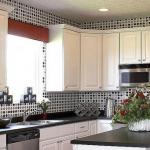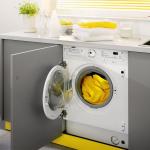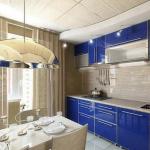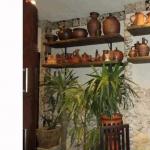Against the background of a well-chosen wall texture, they will radically transform the interior of a small kitchen. To achieve the desired effect, you need to learn the simple rules by which designers select the color, texture and pattern of wallpaper for small kitchens.
Interesting wallpaper in a small kitchen will give personality to the room
Ideally, the design of the kitchen is planned in the context of the design of the entire dwelling, when a schematic drawing of the apartment is first made with a plan for arranging furniture and working out options for wall decoration in each room. If a small kitchen is connected to the living room, this approach is relevant. In other situations, the decoration of a small kitchen is designed to expand the space, regardless of whether its design will conflict with the interior of the rest of the apartment or not.
Color and pattern
When choosing a background color for the walls of the kitchen, they take into account the design features of the room and what associations a certain spectrum causes in a person:
- If the style of interior design does not contradict the use of light shades for wall decoration, then orange, yellow, beige or golden wallpaper will help to expand the space and make the kitchen warm and cozy. They raise the appetite and general tone of a person, promote active communication. But an excess of bright colors tires the eyesight.
- Dark shades visually compress the room, so they are used only in cases where a gloomy background is the main idea of \u200b\u200bthe interior design style. This is conceptual steampunk or popular ethnic styles.
- Plain plain wallpaper is chosen as a background for photo wallpaper. The color is selected according to the principle of matching the primary color or contrasting. In order for the photo wallpaper to look harmonious, the background shade must match.
- Black and white wallpapers can balance bright colors in the interior of the kitchen. The monotony of monochrome furniture will enliven the floral pattern.
- Red color and its shades are characterized by irritating properties, therefore they are used only as small inclusions in interior design to create accents.
- Green is the color of calm and tranquility. Wall murals for a small kitchen with images of a forest theme look harmoniously against a natural background.
- Shades of blue promote relaxation and create an atmosphere of freshness.
 Blue color in the kitchen is exotic
Blue color in the kitchen is exotic
Important! Wall murals for a small kitchen do not accept visual competitors in the interior in the form of additional small wall decor elements.
Photowall-paper is presented by a huge variety of drawings. For the kitchen, select the appropriate theme to taste. With the help of photographic canvases, you can emphasize the purpose of the room. For the smallest members of the family, the dining area is enlivened with paintings with fairy tales. A cartoon drawing of a squirrel or other favorite characters will make them a fun mealtime campaign.
To choose the right background wallpaper pattern for walls, designers recommend following these rules:

Important! The ease of sticking and replacing photo wallpapers allows you to use them for temporary thematic decoration of the kitchen before celebrations or important events. New Year's drawing on the eve of the winter holidays will help create a festive mood.
What type of wallpaper is best for the kitchen
If when choosing wallpaper for other living rooms of an apartment, the main criterion is their design, then the type of material is of great importance for decorating a kitchen.
 Choose wallpapers according to the quality of the material
Choose wallpapers according to the quality of the material
High humidity, microparticles of soot, fat in the air will settle on the surface and spoil the appearance of the decor in a short time. The wallpaper in the kitchen needs regular care, so their surface must withstand wiping with a damp cloth.
Paper and textile wallpapers are unsuitable for use in a kitchen. Special beauty will not be an argument when choosing this type of material, because it will quickly lose its charm under a layer of dirt and will have to be changed. This also applies to liquid wallpaper. Drawing with liquid wallpaper looks creative and unusual, but it is impossible to wash it from dirt and grease-soaked dust. This material is hygroscopic, so it is afraid of moisture. Fiberglass according to its characteristics can be suitable for use in the kitchen. It does not absorb moisture, does not accumulate electrostatic charges, which prevents dust from sticking. This type of material is not widely used for two reasons: high cost and limited design options.
Material suitable for the kitchen is interlining, vinyl.
Thanks to the texture, the unevenness of the wall will be hidden. For their gluing, only the surface of the wall is lubricated with glue, which greatly facilitates and speeds up the repair process.
- When gluing, they do not require careful smoothing, as they keep their shape well, do not stretch or bubble. Ideal for inexperienced craftsmen.
- Due to the high density, they are glued to walls with small cracks without puttying.
- Non-woven murals for the kitchen are suitable for repeated repainting.
- They do not let air through, mold will not appear under them.
- fire resistant;
- Withstand cleaning.
- Do not fade from exposure to ultraviolet radiation.
 Non-woven coating is great for the dining area
Non-woven coating is great for the dining area
Non-woven fabric also has disadvantages:
- Dust collects more intensively on a textured surface, and it is more difficult to remove it than from a smooth surface.
- The outer front layer is not durable, which requires a careful attitude, excluding mechanical impact.
Important! Non-woven wallpaper must be painted. This is both a disadvantage and an advantage.
Vinyl photo wallpaper for kitchen decoration is a wall covering based on non-woven or paper, covered with PVC film. Thanks to the protective coating, they are moisture resistant and can withstand wet cleaning with brushes. They differ from non-woven ones in such characteristics:
- The non-woven base is thin, and stains on the wall can be seen through it. Therefore, before gluing the wall must be puttied so that it gets a light shade over the entire surface.
- This material is heavier than uncoated interlining, so both the wall and the wallpaper are lubricated when gluing. After absorbing moisture, the canvas swells and stretches. This makes it difficult to match the pattern.
- The cost is higher than that of uncoated non-woven fabric.
Important! The designation of the patterns on the label of each roll indicates the basis of the wallpaper, the shift of the pattern, the degree of resistance to moisture and mechanical damage. When calculating the required number of rolls, the pattern shift step must be taken into account. The wave pattern indicates resistance to moisture, and the brush indicates the possibility of wet cleaning with the use of detergents.
High-quality photo wallpaper is more difficult to choose. The method of printing matters. Latex ink is inferior in quality to UV print, but they cost 30% less. The choice of a type-setting panel is closely related to the layout in the kitchen. It is important to choose a picture of such a size that it is not blocked by kitchen furniture.
So that when gluing there are fewer problems with leveling and joining the canvases, the wall must be puttied.
When cutting strips, allowance should be left for changing the height of the room.
The most difficult sections are pasting the corners. When gluing the strip, it is necessary to overlap the adjacent wall. The joining strips are cut so that the joint is at the top of the corner.
Wallpaper with a pattern that requires matching is cut in one strip, applying it to the previous one in the unfolded form.
WATCH VIDEO
When applying glue, carefully coat the edges of the strips. The coating is smoothed with a special plastic spatula, and the excess of protruding glue is wiped off with a dry cloth.
Wall murals in the kitchen will not only be the highlight of the interior. A realistic picture on the wall will clearly express the idea of creative design and combine all design elements into a coherent composition.




